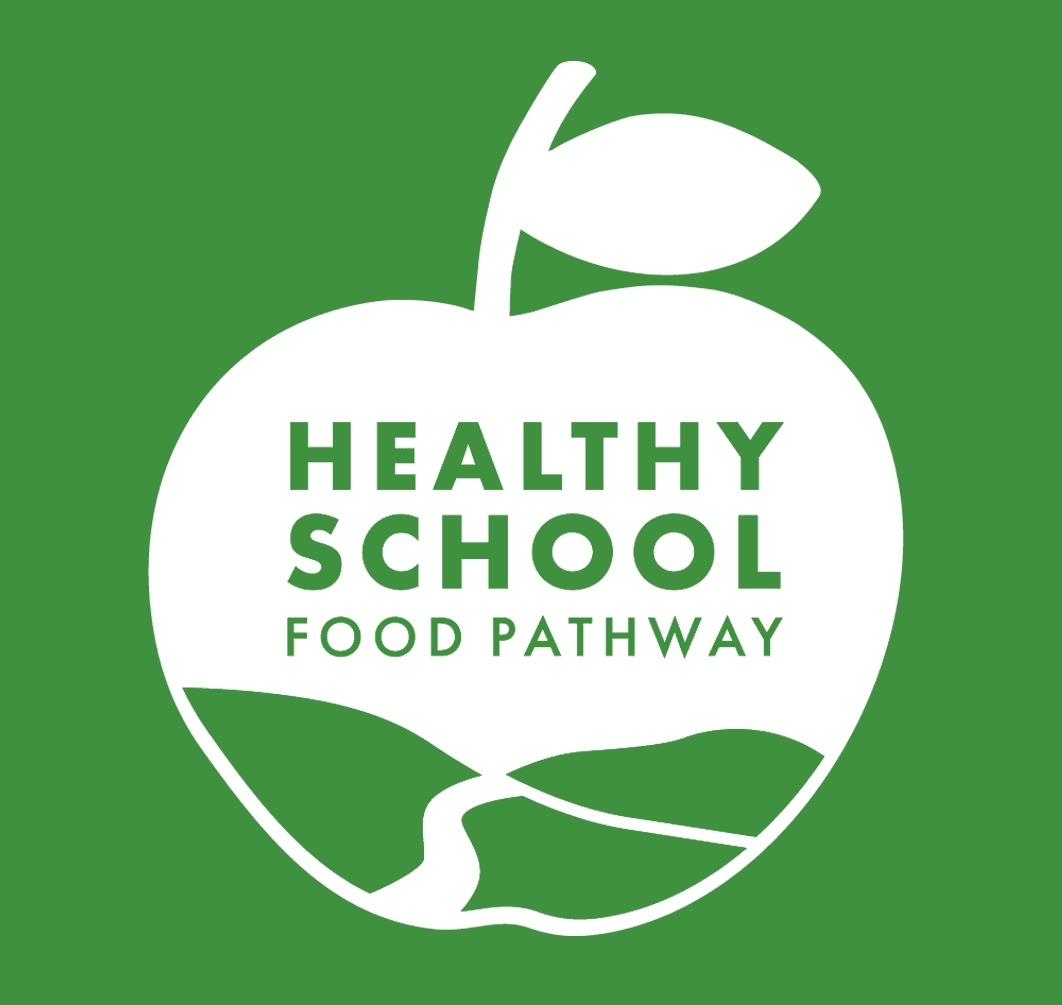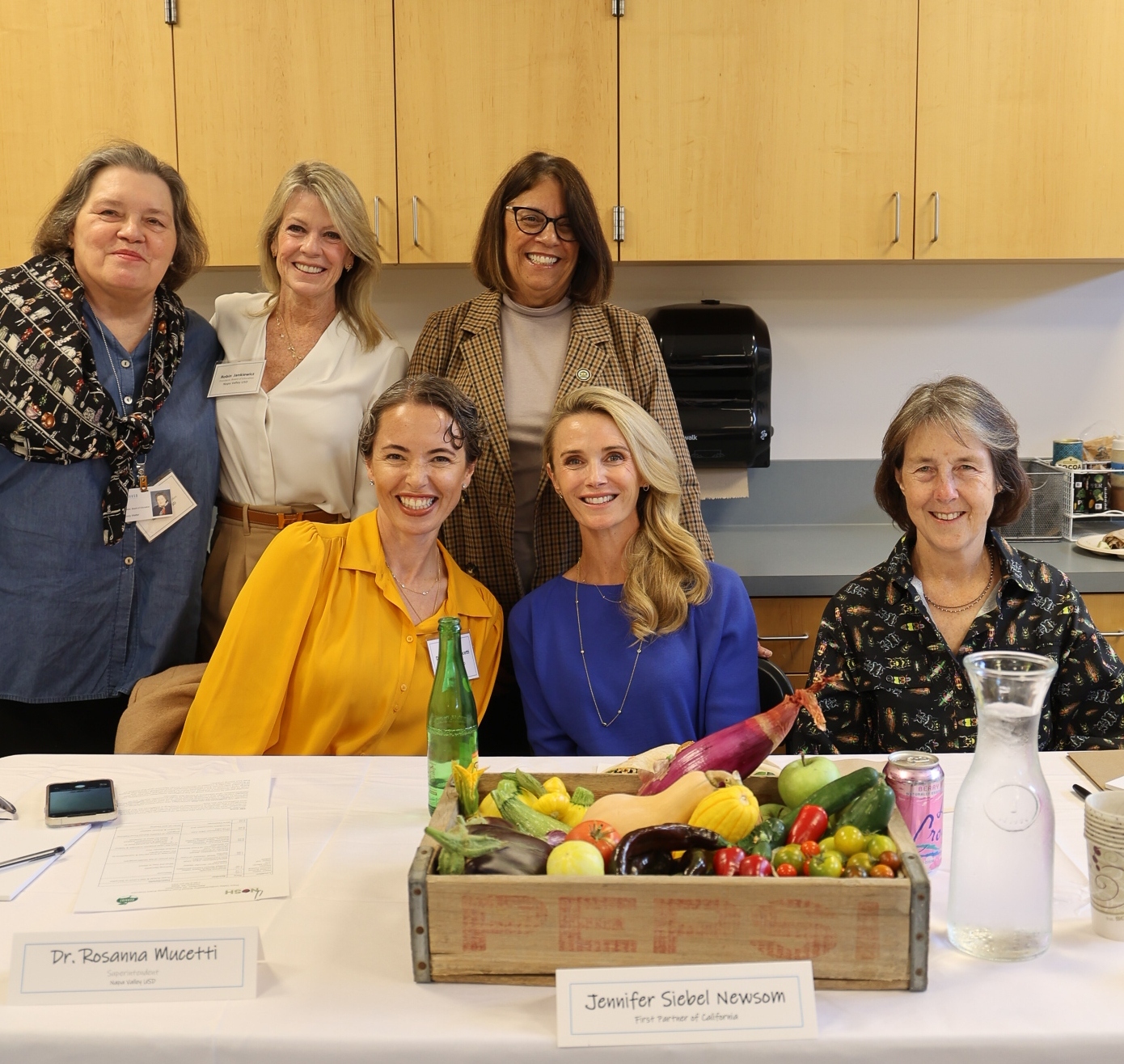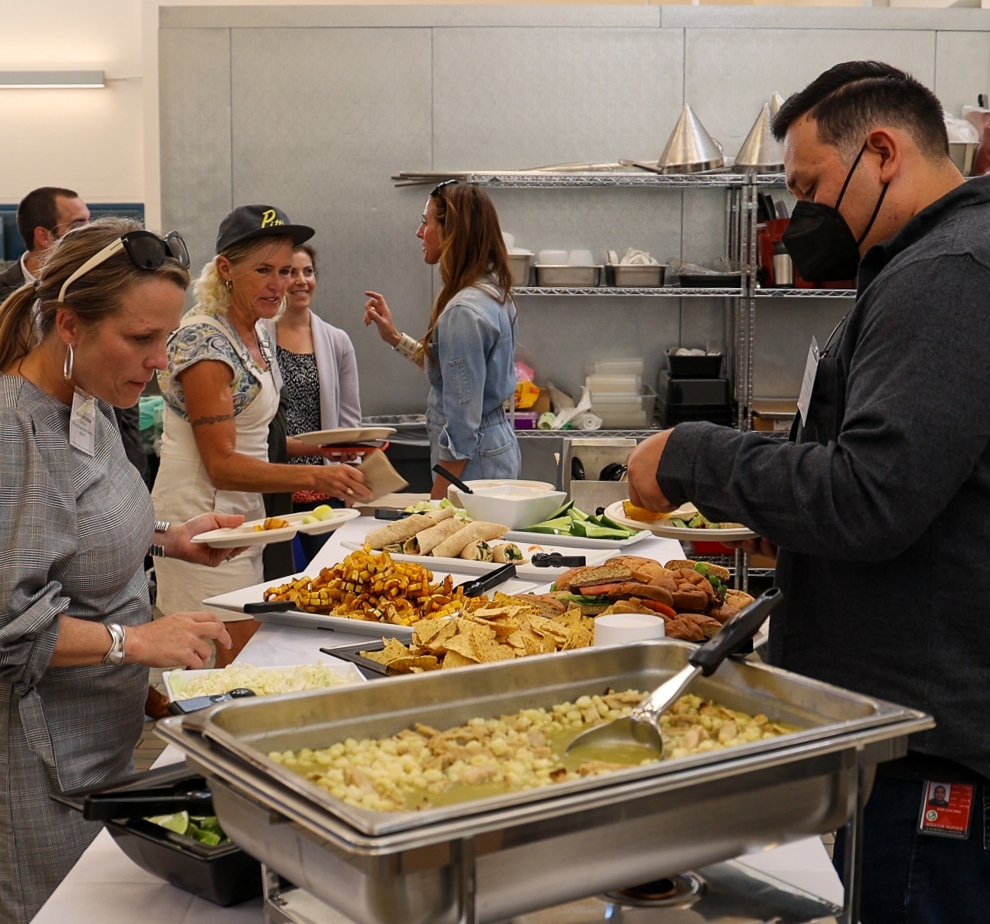
Paving the Way For School Food Change
December 08, 2022 | By Emily Gallivan
Learn about our Healthy School Food Pathway program in partnership with the state of California and how together, we’re paving the way to healthy school meals for all.
Pictured (left to right): CA Senator Nancy Skinner, Chef Ann Foundation CEO Mara Fleishman, First Partner of California Jennifer Siebel Newson, Chef Ann Foundation Senior Director of School Food Operations Brandy Dreibelbis, and CA Assemblymember Cecilia Aguiar-Curry
Behind each school meal is a team member working to serve the best food possible to their students. In this day and age, it’s easy to forget these unsung heroes when social media is flooded with photos of school lunches and opinionated comments. But as recent years have demonstrated, especially with the pandemic, there is care and passion behind school meals. In order to make them even better, what school food teams need isn’t negative sentiments but increased support - whether it be additional team members, higher reimbursement rates, deliveries that arrive on time, training opportunities or the right [working] equipment.
The Chef Ann Foundation (CAF) has always approached school food from a systems-based lens, noting there are numerous pieces to this puzzle. This work has led us to the creation of the Healthy School Food Pathway (HSFP) program to further lift up and grow the school food workforce, alongside a celebration of other historic investments from the state of California.
Building the Pipeline
For the last 13 years, CAF has been working to implement professional development, technical assistance and funding opportunities to support school food programs in serving more scratch-cooked meals. As CAF’s programs were enhanced, the need for more hands-on opportunities to develop diverse school food leaders in the field of scratch-cook operations led to the creation of the HSFP program.
HSFP is a work-based learning experience that aims to prepare individuals for job opportunities in healthy, scratch-cook school food programs. This new program supports workforce readiness and professional growth for new, incumbent, and displaced school food operators. The pipeline offers professionals the resources, hands-on training, and network to become confident leaders, from entry-level positions to school food leaders.


Building the Pipeline
For the last 13 years, CAF has been working to implement professional development, technical assistance and funding opportunities to support school food programs in serving more scratch-cooked meals. As CAF’s programs were enhanced, the need for more hands-on opportunities to develop diverse school food leaders in the field of scratch-cook operations led to the creation of the HSFP program.
HSFP is a work-based learning experience that aims to prepare individuals for job opportunities in healthy, scratch-cook school food programs. This new program supports workforce readiness and professional growth for new, incumbent, and displaced school food operators. The pipeline offers professionals the resources, hands-on training, and network to become confident leaders, from entry-level positions to school food leaders.
California’s Commitment
California’s recent commitment to healthy school meals has set forth an example for other states. California’s final 22-23 budget contains a historic investment, including over 1.9 billion dollars supporting healthy school meals statewide.
The budget specifically included an incredible $45 million for the HSFP program. Without a program that is focused on uplifting and training the next generation of school food professionals, these other investments would be limited in their impact. These leaders are the ones that can ensure each dollar invested is put to good use and creates change within communities.
But it’s not always easy and school food is a complex system with many nuances. We need individuals that understand the importance of procuring local products, especially those coming from regenerative farms. There also needs to be a strong understanding of the right equipment a kitchen needs in order to scratch cook. Additionally, financial literacy is a key component to ensuring meal programs are balanced and sustainable. And, overall, we need a larger and stronger workforce for the increased participation levels that School Meals for All will bring.
We were going in, helping districts change for two or three years and then the food services director would get a job at another district, and they wouldn’t be able to fill that position with someone who had scratch cook program experience. There wasn’t someone below them to move up.
Creating Pathways
The HSFP program officially launched last year as a three-year pilot program in California and strives to address the workforce problem the school food industry has faced for years. The program pairs K-12 districts with community colleges to provide work experience opportunities to students in districts doing a certain level of scratch cooking. The program is also open to individuals already working in school meal programs, from professionals at the entry-level to mid-upper level roles looking for career development opportunities.
The Pre-Apprenticeship and Apprenticeship pathways combine onsite work experience with virtual learning components to provide a holistic understanding of school meals while the Fellowship provides more in-person training opportunities, a capstone project and more. Together these three pathways aim to lift up and educate existing staff while also bringing in new individuals that may have otherwise never considered a career in school food.

Banding Together
After working for nearly 3 years with so many partners in California to launch this program, it was monumental to gather in-person at Napa Valley Unified School District (NVUSD) to see things first-hand and spend time connecting with individuals that had only met over Zoom. The gathering included key stakeholders in the development, launch and expansion of the program, including the Office of the First Partner, the Office of Kat Taylor, California Community Colleges, Department of Education, Department of Food and Agriculture, Department of Labor and key stakeholders from NVUSD.

Banding Together
After working for nearly 3 years with so many partners in California to launch this program, it was monumental to gather in-person at Napa Valley Unified School District (NVUSD) to see things first-hand and spend time connecting with individuals that had only met over Zoom. The gathering included key stakeholders in the development, launch and expansion of the program, including the Office of the First Partner, the Office of Kat Taylor, California Community Colleges, Department of Education, Department of Food and Agriculture, Department of Labor and key stakeholders from NVUSD.
Coming together in-person, in a school food kitchen, to share a meal was an impactful way for this program to celebrate the launch of its pilot phase. Here, individuals were able to share directly about what they see as some of the most pressing issues in school food, and more specifically the school food workforce. NVUSD’s meal program is an exemplary model of scratch cooking in California with a new central kitchen facility and supportive administration. The district’s Food Service Director, Assistant Superintendent and Superintendent each spoke about the importance of school meals and all the work they have accomplished to bring healthy meals to students.


Coming together in-person, in a school food kitchen, to share a meal was an impactful way for this program to celebrate the launch of its pilot phase. Here, individuals were able to share directly about what they see as some of the most pressing issues in school food, and more specifically the school food workforce. NVUSD’s meal program is an exemplary model of scratch cooking in California with a new central kitchen facility and supportive administration. The district’s Food Service Director, Assistant Superintendent and Superintendent each spoke about the importance of school meals and all the work they have accomplished to bring healthy meals to students.
In his remarks, Assistant Superintendent Mike Pearson mentioned that “the district has seen a significant increase in meal participation numbers, while at the same time we are significantly under staffed. We want to continue to grow our program and serve more fresh and local foods but we need the labor to accomplish many of these key goals.” The afternoon also included a tour of the central kitchen facility, highlighting how the district cooks and prepares key ingredients such as local squash and burgers. This event was a unique opportunity where those that don’t always have a ton of overlap could sit together and share stories of their work, bringing us all a bit closer to healthy school meals for all.
Get Involved
To learn more about opportunities within the Healthy School Food Pathway program, click here.
If you are a student interested in applying for the pre-apprenticeship program, click here.
Interested in becoming a participating Healthy School Food Pathway school district? Click here.
To receive updates about the Healthy School Food Pathway program, click here.







